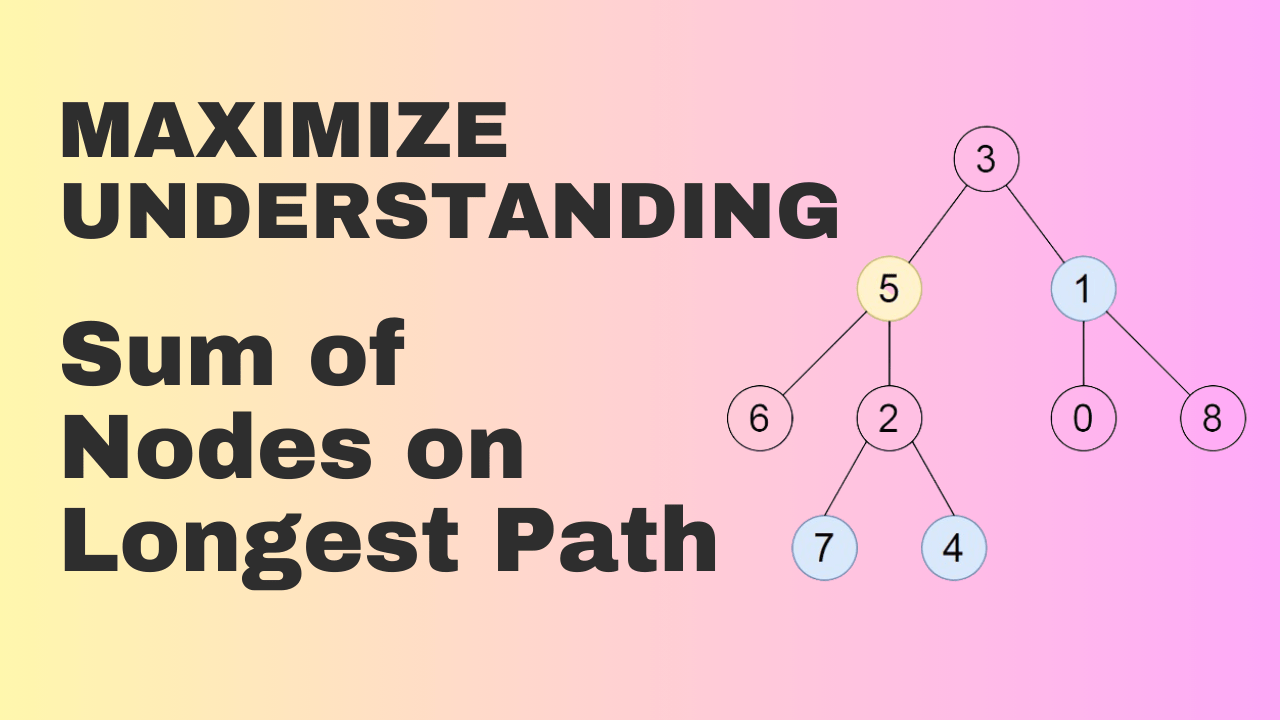In the programming and algorithmic analysis, understanding tree structures is paramount. Trees serve as fundamental data structures in computer science, facilitating the organization and manipulation of hierarchical data. One key aspect of trees is their depth, which signifies the length of the longest path from the root to any leaf node.
Delving deeper into this notion, we encounter the concept of the sum of nodes on the longest path, a metric that holds immense potential in enhancing our comprehension of tree structures and aiding in algorithmic analysis.
Introduction
Trees are ubiquitous in computer science, finding applications in various domains such as databases, artificial intelligence, and networking. Understanding the depth of a tree, i.e., the length of the longest path from the root to any leaf node, is crucial for assessing its structure and performance.
However, merely knowing the depth might not provide sufficient insights into the tree's characteristics. This is where the concept of computing the sum of nodes on the longest path comes into play, offering a deeper understanding of tree structures and their intricacies.
Understanding Tree Depths
- Definition: Tree depth refers to the length of the longest path from the root to any leaf node.
- Importance: Understanding tree depths aids in evaluating the overall structure and complexity of trees, influencing algorithmic decisions and optimizations.
- Algorithmic Analysis: Tree depths play a pivotal role in algorithmic analysis, influencing the time and space complexities of operations performed on trees.
Exploring the Longest Path
- Definition: The longest path in a tree is the path with the maximum number of nodes from the root to any leaf node.
- Finding the Longest Path: Various algorithms, such as depth-first search (DFS) or breadth-first search (BFS), can be employed to find the longest path in a tree.
- Applications: The longest path is utilized in solving problems related to network routing, optimization, and decision-making.
Computing the Sum of Nodes on the Longest Path
- Definition: The sum of nodes on the longest path refers to the summation of values associated with nodes along the longest path in a tree.
- Computation: To compute the sum of nodes on the longest path, we first find the longest path and then sum the values of its constituent nodes.
- Enhanced Understanding: This metric provides deeper insights into the structure and characteristics of trees, aiding in algorithmic analysis and problem-solving.
Advantages of Sum of Nodes on Longest Path
- Enhanced Comprehension: Computing the sum of nodes on the longest path offers a more nuanced understanding of tree structures.
- Simplified Analysis: It simplifies algorithmic analysis by providing a comprehensive metric for assessing tree complexity.
- Optimized Solutions: By leveraging this metric, programmers can optimize their solutions and algorithms for better performance.
Comparing with Other Metrics
| Metric | Sum of Nodes on Longest Path | Other Metrics |
|---|---|---|
| Definition | Sum of values on longest path | Various metrics (e.g., height, depth) |
| Advantages | Enhanced understanding, optimized analysis | Simple computation, different perspectives |
| Applications | Algorithmic analysis, problem-solving | Basic tree evaluation |
Formula for computing the sum of nodes
The formula for computing the sum of nodes on the longest path in a tree can be represented as follows:
Let ( S ) denote the sum of nodes on the longest path.
Let ( T ) denote the binary tree.
The formula can be expressed as:
[ S = \sum_{i=1}^{n} T_i ]
Where:
- ( S ) is the sum of nodes on the longest path.
- ( n ) is the number of nodes on the longest path.
- ( T_i ) represents the value associated with each node along the longest path.
Example: Computing the Sum of Nodes on the Longest Path
Consider a binary tree:
1
/ \
2 3
/ \
4 5- Longest Path: 1 -> 2 -> 4
- Sum of Nodes on Longest Path: 1 + 2 + 4 = 7
Let's take another example:
5
/ \
3 8
/ \ \
7 2 9
/ / \
1 6 4- Longest Path: 5 -> 3 -> 7 -> 1
- Sum of Nodes on Longest Path: 5 + 3 + 7 + 1 = 16
Consider a binary tree with the following another structure:
1
/ \
2 3
/ \ \
4 5 6
- Longest Path: The longest path from the root (1) to a leaf node is 1 → 3 → 6.
- Sum of Nodes: Computing the sum of nodes on this path: 1 + 3 + 6 = 10.
- Insight: By calculating the sum of nodes on the longest path, we obtain valuable information about the critical path within the tree.
Pros and Cons of Computing Sum of Nodes on Longest Path
Pros:
- Provides deeper insights into tree structures.
- Simplifies algorithmic analysis.
- Optimizes programming solutions.
Cons:
- Computational complexity in large trees.
- Potential inaccuracies in implementation.
Conclusion
Understanding tree depths and the longest path is essential for proficient programming and algorithmic analysis. By computing the sum of nodes on the longest path, programmers can gain deeper insights into tree structures, optimize their solutions, and enhance their problem-solving skills.
Embrace the power of this metric today to unlock new dimensions in tree analysis and algorithm design. We invite you to share your thoughts and experiences with us in the comments below.
FAQs (Frequently Asked Questions)
What is the significance of computing the sum of nodes on the longest path?
Answer: Computing the sum of nodes on the longest path offers a deeper understanding of tree structures and aids in algorithmic analysis.
Can the sum of nodes on the longest path be negative?
Answer: No, the sum of nodes on the longest path cannot be negative, as it represents the summation of values associated with nodes.
Are there any efficient algorithms for computing the sum of nodes on the longest path?
Answer: Yes, various efficient algorithms, such as depth-first search (DFS) or breadth-first search (BFS), can be used to compute the sum of nodes on the longest path.



Write a comment